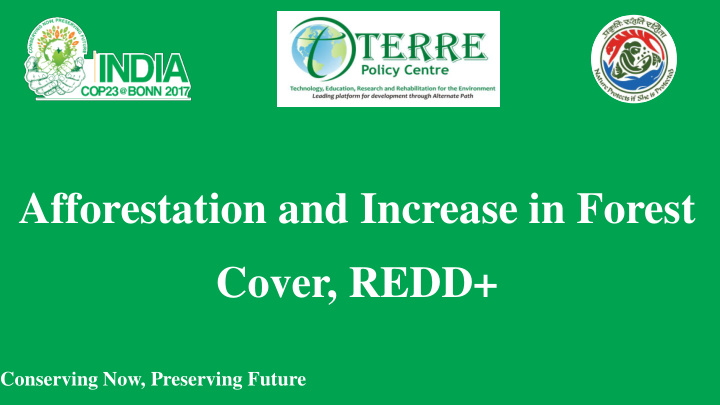



Afforestation and Increase in Forest Cover, REDD+ Conserving Now, Preserving Future
Introduction • The United Nations Collaborative Programme on Reducing Emissions from Deforestation and Forest Degradation (REDD) in Developing Countries was launched in 2008 and builds on the convening role and technical expertise of the Food and Agriculture Organization of the United Nations (FAO), the United Nations Development Programme (UNDP) and the United Nations Environment Programme (UNEP). • The UN-REDD (Reducing Emission from Deforestation and Degradation)Programme supports nationally led REDD+ processes and promotes the informed and meaningful involvement of all stakeholders, including indigenous people and other forest-dependent communities, in national and international REDD+ implementation. Conserving Now, Preserving Future
Urban Forestry, Warje (2015-2016) Planted Trees • 16 Hectare Of waste barren hill land used as dump yard • Pipal • 9000 indigenous tree planted • Banyan • • Almond Increase Biodiversity – Identified, 30 Bird Diversity, 400 insects & Moth, Reptiles, • Neem Rabbits, etc. • Sonchafa • Kanchan • Involved local community for maintained and incentive generation through grass • Palm cutting, employment, Honey generation, etc. under REDD+ Initiative • Bamboo • Amla • People engagement - Every day more than 2000 people come for morning and • Sapthaparni • Neelmohar evening walk. • Ashoka • Installed honeybee boxes- helps in economic generation and pollination • Rudrakash Conserving Now, Preserving Future
January 2015 Conserving Now, Preserving Future
August 2016 Conserving Now, Preserving Future
Current Situation Conserving Now, Preserving Future
Butterfly (commonly seen) Conserving Now, Preserving Future
Biodiversity (commonly seen) Birds • Ashy prinia • Scaly breasted munia Butterfly Snakes • Baya weaver • Red whiskered bulbul • Spectacled Cobra (Naja naja) • • Oriental white eye Angled Castor (Ariadne Ariadne) • Saw Scaled Viper (Echis carinatus) • • Brown kite Common Indian crow (Euploea core) • Russell Viper (Daboia ruselii) • • Grey prinia Common grass yellow (Eurema • Banded Racer (Argyrogena fasciolata) • hekabe) Oriental magpie robin • Rat snake (Ptyas mucosa) • • Blue tiger (Tirumala limniace) Indian robin • Common trinket snake (Coelognathus helena • • Common mime (Chilasa clytia) Asian koel helena) • • Baronet (Euthalia nais) • Pond heron Striped Keelback (Amphiesma stolatum) • • Bright babul blue (Azanus ubaldus) Little egret • • Common hedge blue (Acytolepis Cattle egret • puspa) Blue rock pigeon • • Great eggfly (Hypolimnas bolina) House swift • Plains cupid (Chilades pandava) • Brahminy starling • • Spotless grass yellow (Eurema laeta) Common myna • • Blue pancy (Junonia orithya) House sparrow • • Brown owl (Badamia exclamationis) Common babbler • Tailor bird • Barn swallow Conserving Now, Preserving Future
Graphical Representation The Plantation helps in reducing 285,000 Pounds of carbon per year and produce 1,520,000 Pounds of Oxygen Per year Conserving Now, Preserving Future
Urban Forestry, Mhalunge (2017 -18) Planted Trees • 32.68 Hectare Of waste barren hill land used as dump yard • Pipal • • Banyan 15000 indigenous tree planted • Almond • Increase in bird and insects diversity within a month • Neem • chafa • Involved local community for maintained and incentive generation through grass • Kanchan • cutting, employment, Honey generation, etc. under REDD+ Initiative Amla • Sapthaparni • Plant size 10 - 12 Feet , With bag size 18 x 18 • Neelmohar • Ashoka • Installed honeybee boxes- helps in economic generation and pollination • Spethodiya • Millingtoniya • Mahugani • Arjun Conserving Now, Preserving Future
June 2017 Conserving Now, Preserving Future
Current Situation Conserving Now, Preserving Future
Graphical Representation The Plantation helps in reducing 360,000 Pounds of carbon per year and produce 1,500,000 Pounds of Oxygen Per year Conserving Now, Preserving Future
Conclusion • India is playing a positive role and has taken a firm stance in favor of a comprehensive REDD+ (Reducing Emissions from Deforestation and Forest Degradation) approach. • It has presented an ambitious Green India Mission Programme under its National Action Plan on Climate Change. • India believes REDD needs to be seen in the broader context of REDD+, not in isolation or in a turncated form since reduction of deforestation, and conservation and improvement of forests are two sides of the same coin, and so should be treated at par. Conserving Now, Preserving Future
Thankyou… Thankyou…… Conserving Now, Preserving Future
Recommend
More recommend